If you ever wanted to get your “water efficiency and conservation on,” there was no better place to do that than the International Emerging Technology Symposium (IETS)—spearheaded by IAPMO—held back in April in Washington, D.C.
Where else other than the nation’s capital would you find some of the top industry influencers discussing water efficiency and the progress we are making/can be making? Some of the best set of speakers and panelists that I have been a part of were assembled at the 4th—every-other-year—IETS Symposium to discuss new technologies in the water management arena; provide outstanding networking opportunities to meet experts in the fields of water and energy efficiency; expose participants to emerging products and practices; exchange views on new trends in the industry; and share ideas and approaches on bringing emerging technologies to market.
The two-day event was keynoted by Nancy Stoner, acting assistant administrator for the Office of Water at the EPA, where she leads the agency’s work to protect the nation’s water resources. Top of mind for Stoner and the agency was 10 opportunities for water technology innovation. Here are some of the hot buttons:
• Conserving and recovering energy — 150,000 drinking water and 15,000 wastewater treatment plants consume 2-4% of the nation’s electricity per year. “Imagine a future when water, wastewater and agricultural activities can cost effectively generate as much energy as they consume,” suggests Stoner.
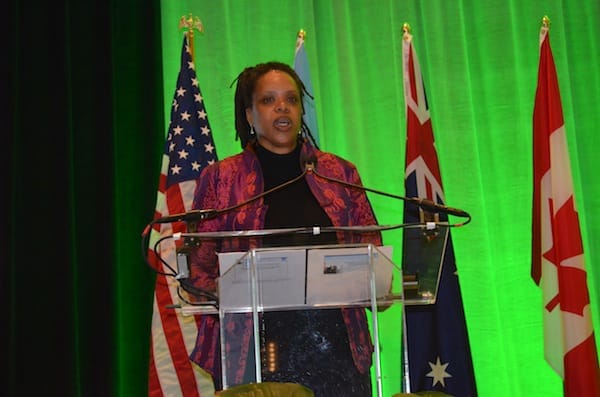
Stephanie Tanner lead engineer, U.S. Environmental Protection Agency’s WaterSense program discusses the WaterSense plan.
• Recovering nutrients — Nitrogen and phosphorous pollution are the leading causes of the nation’s water pollution, and 14,000 water bodies are affected by nutrient pollution. “What if we could recover nutrients from human and animal wastes and convert them into marketable commodities before they impact the surface and ground water.”

The Hub’s John Mesenbrink moderates a panel discussion on “Emerging Issues and Solutions on Wastewater.” Panelists (from l to r:) Silvano Ferrazzo, director of business development, Green Turtle America, Ltd.; Casey Furlong, environmental specialist, InSinkErator; Adam Krantz, managing director, Government & Public Affairs, The National Association of Clean Water Agencies (NACWA); David Powling, Family Care R&E technical leader, Kimberly Clark Corporation; and Hiram Tanner, manager for the District of Columbia’s Water and Sewer Authority (DC Water).
• Improving and greening of water infrastructure — The rehabilitation of water and sewer infrastructure is estimated to cost more than $682 billion. The need calls for more green/natural infrastructure as not only building or rebuilding infrastructure but rebuilding habitat biodiversity, less heat stress, improved air quality and aesthetic value.
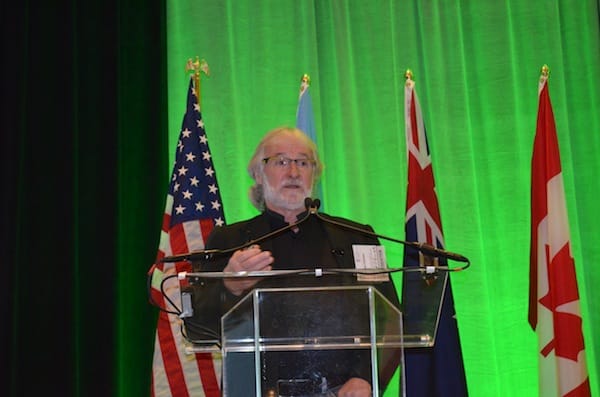
Don Fisher, principal, Fisher Consultants, LLC, talks about innovative technologies in commercial foodservice.
• Conservation and reuse of water — 15,000 municipal wastewater facilities discharge approximately 32 billion gallons of water every day. The U.S. reuses an estimated 5% of our water whereas countries like Israel reuses nearly 70% and Singapore reuses and estimated 90% of their water.

The panel discussion “Legionella – Risk and Mitigation” featured (from l to r): Dr. Jamie Bartram, director, The Water Institute at the University of North Carolina; Joe Cotruvo – principal, Joseph Cotruvo & Associates LLC; Ron George, president, Plumb-Tech Design & Consulting Services LLC; Tim Keane – consultant, Legionella Risk Management, Inc.; and Dr. Janet Stout – PhD, Special Pathogens Laboratory.
• Reducing costs and improving water monitoring techniques — Improved water quality sensor technology, remote sensing and satellite imagery to generate more data at lower costs.
• Improving resiliency of water infrastructure to the impacts of climate change — Super Storm Sandy affected 60 million people and caused $50 billion in damage; storm affected 690+ water and wastewater utilities, which provide a critical lifelines. There is a need for increased preparedness to extreme weather events.
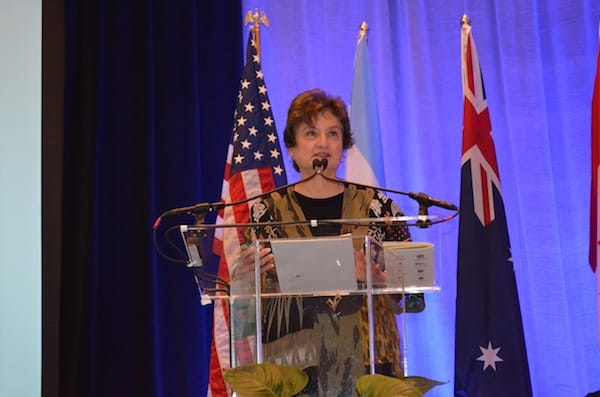
Mary Ann Dickinson, Alliance for Water Efficiency (AWE), discusses “The Water and Energy Nexus: What Are We Waiting For?”
Other noteworthy speakers and panels included:
• Water and Energy Nexus Research — Mary Ann Dickinson, president and CEO, Alliance for Water Efficiency (AWE), spoke about AWE and its partner the American Council for an Energy‐Efficient Economy (ACEEE), which investigated the issue of existing water-energy nexus research. Our report Water‐Energy Nexus Research: Recommendations for Future Opportunities assesses the research conducted to date and identifies priority research areas to enhance integrated resource management and to support overall efficiencies. “Improve awareness, funding and integrated management of water and efficiency resources on national, regional and local levels,” said Dickinson.

Contractor magazine’s chief editor Bob Mader moderates a panel discussion on “The IETS: Where Technology Meets Policy.” Guest include (from l to r): Kim Glas, deputy assistant secretary, International Trade Administration, U.S. Department of Commerce; Brian Gilligan, PE, LEED-AP, (BD+C) sustainability program manager, General Services Administration; Eric Mucklow, AIA CPHC, lead architect, Sustainable Technologies, US Army Corps of Engineers; and Andrew Sawyers, director, Office of Wastewater Management, US Environmental Protection Agency.
• Three Emerging Technologies That Save Water and Energy — Bill Hoffman, president, president: H.W. (Bill) Hoffman & Associates, LLC, talked about three technologies and techniques that hold promise to save both water and energy include: 1. Eliminate tempering water requirements for small flows over 140 F; 2. Combined heat and power for commercial and institutional applications; and 3. Combined irrigation efficiency and stormwater management.
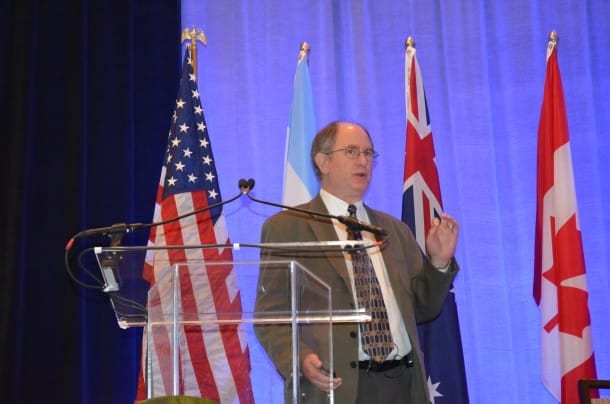
Gary Klein, Affiliated International Management, LLC, presents “Comparing the Energy Requirements of Hot Water Circulation System Control Strategies.”
• Making the Business Case for Increased Use of Thermal Insulation on Domestic Hot Water Systems — Chris Crall, technical consultant, National Insulation Association iterated that before regulators, code officials, designers, owners and others will consider the advantage of expanding the scope of pipe insulation, the impact on energy efficiency, conservation of water and the business case and economics, must be determined and supported by industry. This National Institute of Building Sciences Consultative Council Energy & Water Topical Committee has formed a task force to determine the impact of thermal insulation on both energy and water use on potable hot water, and other similar distribution systems, and to examine the business case and return on investment of that opportunity.

Arguably the brains behind the IETS, Pete DeMarco, senior vice president of advocacy, Research and Program Development at IAPMO, addresses the crowd with his esteemed industry guests—who helped organize the event—behind him (from l to r): Michael Gardner, executive vice president, Compliance Programs at International Code Council; Jim Kendzel, executive director, ASPE; Gerry Kennedy, executive vice president, PHCC-NA; Barbara Higgens, executive director, PMI; Mary Ann Dickinson, president and CEO, AWE; and James McHale, vice president, Research, Development & Engineering at American Standard. Seated is Bob Miodonski, editorial director for P&M magazine.
• Flushing Out Concerns with High-efficiency Commercial Toilets — Stephanie Tanner lead engineer, U.S. Environmental Protection Agency’s WaterSense and Robert Pickering, environmental engineer, Eastern Research Group Inc., plot the path for WaterSense in Irrigation—soil moisture-based controls and emission devices; residential products—water softening systems, whole house humidifiers and water treatment systems; commercial products—flushometer valve toilets and kitchen equipment; and water meters. Of significance, WaterSense is in the process of conducting testing to gauge the existing performance capacity of flushometer valve toilets, where a new protocol would verify the effectiveness of these toilets in commercial settings.
I had the distinct honor to moderate one of the roundtable discussions on “Emerging Issues and Solutions on Wastewater,” where panelists discussed issues related to fats, oils and grease (FOG) in sewer systems. Also, the topic of flushable wipes was discussed.
Other important panels included “Legionella: Risk and Mitigation” and “Where Technology meets Policy.” The latter produced an interesting question where attendee Bill Erickson, C.J. Erickson Plumbing Co., Chicago, asked, “I realize the topic is called ‘Where Technology Meets Policy’ but what happens when technology meets politics?” To which, one of the panelists replied that in the best interest of keeping his job, he could answer that questions privately. Interesting.
Honestly, this is a can’t-miss event. Make plans to be there in 2016 when the IETS reconvenes to discuss topics that are important to this industry.


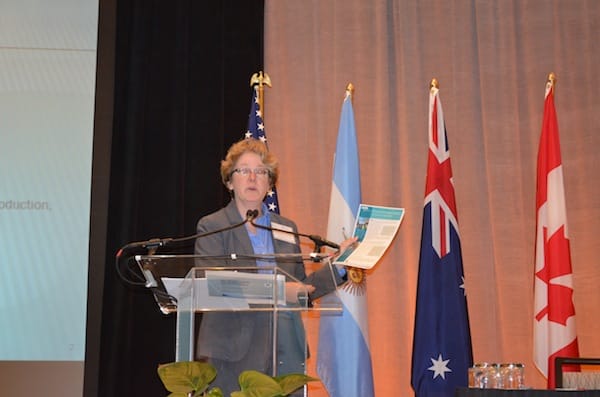



Join the conversation: